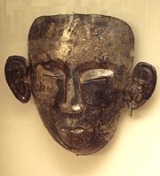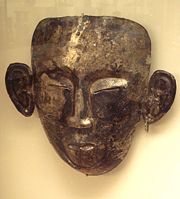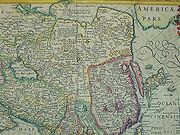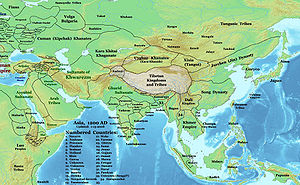
Kara-Khitan Khanate
Encyclopedia
The Kara-Khitan Khanate, or Western Liao (Mongolian
: Хар Хятан; ) (1124-1218) was a Khitan
empire in Central Asia
. The dynasty was founded by Yelü Dashi
, who led the remnants of the Liao Dynasty
to Central Asia after fleeing from the Jurchen conquest of their homeland in North and Northeast of modern day China. The empire was usurped by the Naimans
under Kuchlug
in 1211; traditional Chinese, Persian and Arab sources consider the usurpation to be the end of the empire. The empire was later destroyed by the Mongol Empire
in 1218.
 Kara Khitan (Hala Qidan) was the name used by the Khitans to refer to themselves. The phrase is often translated as the Black Khitans in Turkish, but its original meaning is unclear today. On the same line, "Kara-Khitan" literally means in Mongolian "Khar (Хар) Kidan(Хятан), Since no direct records from the empire survive today, the only surviving historical records about the empire come from outside sources. Since the empire took on trappings of a Chinese state, Chinese historians generally refer to the empire as the Western Liao Dynasty, emphasizing its continuation from the Liao Dynasty in North and Northeast China. The Jurchens referred to the empire as Dashi or Dashi Linya (after its founder), to reduce any claims the empire may have had to the old territories of the Liao Dynasty. Muslim historians initially referred to the state simply as Khitay or Khitai. It was only after the Mongol conquest that the state began to be referred to in the Muslim world as the Kara-Khitai or Qara-Khitai.
Kara Khitan (Hala Qidan) was the name used by the Khitans to refer to themselves. The phrase is often translated as the Black Khitans in Turkish, but its original meaning is unclear today. On the same line, "Kara-Khitan" literally means in Mongolian "Khar (Хар) Kidan(Хятан), Since no direct records from the empire survive today, the only surviving historical records about the empire come from outside sources. Since the empire took on trappings of a Chinese state, Chinese historians generally refer to the empire as the Western Liao Dynasty, emphasizing its continuation from the Liao Dynasty in North and Northeast China. The Jurchens referred to the empire as Dashi or Dashi Linya (after its founder), to reduce any claims the empire may have had to the old territories of the Liao Dynasty. Muslim historians initially referred to the state simply as Khitay or Khitai. It was only after the Mongol conquest that the state began to be referred to in the Muslim world as the Kara-Khitai or Qara-Khitai.
 The Khitans ruled from their capital at Balasagun
The Khitans ruled from their capital at Balasagun
(in today's Kyrgyzstan
). They directly controlled the central region of the empire. The rest of their empire consisted of highly-autonomous vassalized states, primarily Khwarezm
, the Karluks, the Gaochang
Uyghurs
, the Qangli and the Western, Eastern and Fergana Kara-Khanids
. The late-arriving Naimans also became vassals, before usurping the empire under Kuchlug
.
The Khitan rulers adopted many administrative elements from the Liao Dynasty, including the use of Confucian
administration and imperial trappings. The empire also adopted the title of Gurkhan (universal Khan). The Khitans used the Chinese calendar, maintained Chinese imperial and administrative titles, gave its emperors reign names, used Chinese-styled coins, and sent imperial seals to its vassals. Although most of its administrative titles were derived from Chinese, the empire also adopted local administrative titles, such as tayangyu (Turkic) and vizier
.
The Khitans maintained their old customs, even in Central Asia. They remained nomads, adhered to their traditional dress and maintained the religious practices followed by the Liao Dynasty Khitans. The ruling elite tried to maintain the traditional marriages between the Yelü king clan and the Xiao queen clan, and were highly reluctant to allow their princesses to marry outsiders. The Kara-Khitai Khitans followed a mix of Buddhism
and traditional Khitan religion, which included fire worship and tribal customs, such as the tradition of sacrificing a gray ox with a white horse. In an innovation unique to the Kara-Khitai, the Khitans paid their soldiers a salary.
The empire ruled over a diverse population that was quite different from its rulers. The majority of the population was sedentary, although the population suddenly became more nomadic during the end of the empire, due to the influx of Naimans. The majority of their subjects were Muslims, although a significant minority practiced Buddhism and Nestorianism
. Although Chinese and Khitan were the primary languages of administration, the empire also administered in Persian and Uyghur
.
 The Kara-Khitai empire was established by Yelü Dashi
The Kara-Khitai empire was established by Yelü Dashi
, who led 100,000 Khitans into Central Asia from Manchuria by way of Mongolia. Yelü conquered Balasagun from the Kara-Khanid Khanate
in 1134, which marks the start of the empire in Central Asia. The Khitan forces were soon joined by 10,000 Khitans, who had been subjects of the Kara-Khanid Khanate. The Khitans then conquered Kashgar
, Khotan
, and Besh Baliq. The Khitans defeated the Western Kara-Khanid Khanate at Khujand
in 1137, eventually leading to their control over the Fergana Valley
. They won the Battle of Qatwan
against the Western Kara-Khanids and the Seljuk Empire on September 9, 1141, which allowed the Khitans to gain control over Transoxania.
Yelü soon died in 1143, and was followed by his wife, Xiao Tabuyan, as regent for their son. Their son, Yelü Yiliu, died in 1163 and was succeeded by his sister, Yelü Pusuwan. She sent her husband, Xiao Duolubu, on many military campaigns. She then fell in love with his younger brother, Xiao Fuguzhi. They were executed in 1177 by her father-in-law, Xiao Wolila, who then placed Yelü Zhilugu on the throne in 1178. The empire was weakened by rebellions and internal wars among its vassals, especially during the latter parts of its history. In 1208, the Naimans fled from their homeland and were welcomed into the empire of the Kara-Khitai. In 1211, the Naiman prince, Kuchlug, captured Yelü Zhilugu while the latter was hunting, ending Khitan rule in the Kara-Khitai empire. The Mongols captured and killed Kuchlug in 1218. The Mongols fully conquered the former territories of the Kara-Khitai in 1220.
Mongolian language
The Mongolian language is the official language of Mongolia and the best-known member of the Mongolic language family. The number of speakers across all its dialects may be 5.2 million, including the vast majority of the residents of Mongolia and many of the Mongolian residents of the Inner...
: Хар Хятан; ) (1124-1218) was a Khitan
Khitan people
thumb|250px|Khitans [[Eagle hunting|using eagles to hunt]], painted during the Chinese [[Song Dynasty]].The Khitan people , or Khitai, Kitan, or Kidan, were a nomadic Mongolic people, originally located at Mongolia and Manchuria from the 4th century...
empire in Central Asia
Central Asia
Central Asia is a core region of the Asian continent from the Caspian Sea in the west, China in the east, Afghanistan in the south, and Russia in the north...
. The dynasty was founded by Yelü Dashi
Yelü Dashi
Yelü Dashi , or Yeh-Lü Ta-Shih was the founder of the Western Liao dynasty, or the Kara-Khitan Khanate....
, who led the remnants of the Liao Dynasty
Liao Dynasty
The Liao Dynasty , also known as the Khitan Empire was an empire in East Asia that ruled over the regions of Manchuria, Mongolia, and parts of northern China proper between 9071125...
to Central Asia after fleeing from the Jurchen conquest of their homeland in North and Northeast of modern day China. The empire was usurped by the Naimans
Naimans
The Naimans, also Naiman Turks or Naiman Mongols, was a Mongolian name given to a group of people dwelling on the steppe of Central Asia, having diplomatic relations with the Kara-Khitan, and subservient to them until 1177...
under Kuchlug
Kuchlug
Kuchlug was a member of the Naiman tribe of western Mongolia. He was defeated by Genghis Khan and fled westward to the Kara-Khitan Khanate, where he became an advisor. In 1210, he took control of the khanate...
in 1211; traditional Chinese, Persian and Arab sources consider the usurpation to be the end of the empire. The empire was later destroyed by the Mongol Empire
Mongol Empire
The Mongol Empire , initially named as Greater Mongol State was a great empire during the 13th and 14th centuries...
in 1218.
Names

Administration

Balasagun
Balasagun was an ancient Soghdian city in modern-day Kyrgyzstan, located in the Chui River valley between Bishkek and Issyk-Kul Lake....
(in today's Kyrgyzstan
Kyrgyzstan
Kyrgyzstan , officially the Kyrgyz Republic is one of the world's six independent Turkic states . Located in Central Asia, landlocked and mountainous, Kyrgyzstan is bordered by Kazakhstan to the north, Uzbekistan to the west, Tajikistan to the southwest and China to the east...
). They directly controlled the central region of the empire. The rest of their empire consisted of highly-autonomous vassalized states, primarily Khwarezm
Khwarezm
Khwarezm, or Chorasmia, is a large oasis region on the Amu Darya river delta in western Central Asia, which borders to the north the Aral Sea, to the east the Kyzylkum desert, to the south the Karakum desert and to the west the Ustyurt Plateau...
, the Karluks, the Gaochang
Gaochang
Gaochang is the site of an ancient oasis city built on the northern rim of the inhospitable Taklamakan Desert in Xinjiang, China. A busy trading center, it was a stopping point for merchant traders traveling on the Silk Road...
Uyghurs
Uyghur people
The Uyghur are a Turkic ethnic group living in Eastern and Central Asia. Today, Uyghurs live primarily in the Xinjiang Uyghur Autonomous Region in the People's Republic of China...
, the Qangli and the Western, Eastern and Fergana Kara-Khanids
Kara-Khanid Khanate
The Kara-Khanid Khanate was a confederation of Turkic tribes ruled by a dynasty known in literature as the Karakhanids or Ilek Khanids, . Both dynastic names represent titles with Kara Kağan being the most important Turkish title up till the end of the dynasty.The Khanate ruled Transoxania in...
. The late-arriving Naimans also became vassals, before usurping the empire under Kuchlug
Kuchlug
Kuchlug was a member of the Naiman tribe of western Mongolia. He was defeated by Genghis Khan and fled westward to the Kara-Khitan Khanate, where he became an advisor. In 1210, he took control of the khanate...
.
The Khitan rulers adopted many administrative elements from the Liao Dynasty, including the use of Confucian
Confucianism
Confucianism is a Chinese ethical and philosophical system developed from the teachings of the Chinese philosopher Confucius . Confucianism originated as an "ethical-sociopolitical teaching" during the Spring and Autumn Period, but later developed metaphysical and cosmological elements in the Han...
administration and imperial trappings. The empire also adopted the title of Gurkhan (universal Khan). The Khitans used the Chinese calendar, maintained Chinese imperial and administrative titles, gave its emperors reign names, used Chinese-styled coins, and sent imperial seals to its vassals. Although most of its administrative titles were derived from Chinese, the empire also adopted local administrative titles, such as tayangyu (Turkic) and vizier
Vizier
A vizier or in Arabic script ; ; sometimes spelled vazir, vizir, vasir, wazir, vesir, or vezir) is a high-ranking political advisor or minister in a Muslim government....
.
The Khitans maintained their old customs, even in Central Asia. They remained nomads, adhered to their traditional dress and maintained the religious practices followed by the Liao Dynasty Khitans. The ruling elite tried to maintain the traditional marriages between the Yelü king clan and the Xiao queen clan, and were highly reluctant to allow their princesses to marry outsiders. The Kara-Khitai Khitans followed a mix of Buddhism
Buddhism
Buddhism is a religion and philosophy encompassing a variety of traditions, beliefs and practices, largely based on teachings attributed to Siddhartha Gautama, commonly known as the Buddha . The Buddha lived and taught in the northeastern Indian subcontinent some time between the 6th and 4th...
and traditional Khitan religion, which included fire worship and tribal customs, such as the tradition of sacrificing a gray ox with a white horse. In an innovation unique to the Kara-Khitai, the Khitans paid their soldiers a salary.
The empire ruled over a diverse population that was quite different from its rulers. The majority of the population was sedentary, although the population suddenly became more nomadic during the end of the empire, due to the influx of Naimans. The majority of their subjects were Muslims, although a significant minority practiced Buddhism and Nestorianism
Nestorianism
Nestorianism is a Christological doctrine advanced by Nestorius, Patriarch of Constantinople from 428–431. The doctrine, which was informed by Nestorius's studies under Theodore of Mopsuestia at the School of Antioch, emphasizes the disunion between the human and divine natures of Jesus...
. Although Chinese and Khitan were the primary languages of administration, the empire also administered in Persian and Uyghur
Uyghur language
Uyghur , formerly known as Eastern Turk, is a Turkic language with 8 to 11 million speakers, spoken primarily by the Uyghur people in the Xinjiang Uyghur Autonomous Region of Western China. Significant communities of Uyghur-speakers are located in Kazakhstan and Uzbekistan, and various other...
.
History

Yelü Dashi
Yelü Dashi , or Yeh-Lü Ta-Shih was the founder of the Western Liao dynasty, or the Kara-Khitan Khanate....
, who led 100,000 Khitans into Central Asia from Manchuria by way of Mongolia. Yelü conquered Balasagun from the Kara-Khanid Khanate
Kara-Khanid Khanate
The Kara-Khanid Khanate was a confederation of Turkic tribes ruled by a dynasty known in literature as the Karakhanids or Ilek Khanids, . Both dynastic names represent titles with Kara Kağan being the most important Turkish title up till the end of the dynasty.The Khanate ruled Transoxania in...
in 1134, which marks the start of the empire in Central Asia. The Khitan forces were soon joined by 10,000 Khitans, who had been subjects of the Kara-Khanid Khanate. The Khitans then conquered Kashgar
Kashgar
Kashgar or Kashi is an oasis city with approximately 350,000 residents in the western part of the Xinjiang Uyghur Autonomous Region of the People's Republic of China. Kashgar is the administrative centre of Kashgar Prefecture which has an area of 162,000 km² and a population of approximately...
, Khotan
Khotan
Hotan , or Hetian , also spelled Khotan, is the seat of the Hotan Prefecture in Xinjiang, China. It was previously known in Chinese as 于窴/於窴 and to 19th-century European explorers as Ilchi....
, and Besh Baliq. The Khitans defeated the Western Kara-Khanid Khanate at Khujand
Khujand
Khujand , also transliterated as Khudzhand, , formerly Khodjend or Khodzhent until 1936 and Leninabad until 1991, is the second-largest city of Tajikistan. It is situated on the Syr Darya River at the mouth of the Fergana Valley...
in 1137, eventually leading to their control over the Fergana Valley
Fergana Valley
The Fergana Valley or Farghana Valley is a region in Central Asia spreading across eastern Uzbekistan, Kyrgyzstan and Tajikistan. Divided across three subdivisions of the former Soviet Union, the valley is ethnically diverse, and in the early 21st century was the scene of ethnic conflict...
. They won the Battle of Qatwan
Battle of Qatwan
The Battle of Qatwan was fought in September 1141 between the Kara-Khitan Khanate and the Seljuq Empire and its vassal-state the Kara-Khanids. Following the Kara-Khanid defeat at Khujand, Mahmud summoned his overlord Ahmed Sanjar to protect Western Kara-Khanid from invasion.-Battle:On the Qatwan...
against the Western Kara-Khanids and the Seljuk Empire on September 9, 1141, which allowed the Khitans to gain control over Transoxania.
Yelü soon died in 1143, and was followed by his wife, Xiao Tabuyan, as regent for their son. Their son, Yelü Yiliu, died in 1163 and was succeeded by his sister, Yelü Pusuwan. She sent her husband, Xiao Duolubu, on many military campaigns. She then fell in love with his younger brother, Xiao Fuguzhi. They were executed in 1177 by her father-in-law, Xiao Wolila, who then placed Yelü Zhilugu on the throne in 1178. The empire was weakened by rebellions and internal wars among its vassals, especially during the latter parts of its history. In 1208, the Naimans fled from their homeland and were welcomed into the empire of the Kara-Khitai. In 1211, the Naiman prince, Kuchlug, captured Yelü Zhilugu while the latter was hunting, ending Khitan rule in the Kara-Khitai empire. The Mongols captured and killed Kuchlug in 1218. The Mongols fully conquered the former territories of the Kara-Khitai in 1220.
Sovereigns of Kara-Khitan Khanate
| Temple Names ( Miao Hao 廟號 miàohào) | Posthumous Names ( Shi Hao 諡號 shìhào) | Birth Names | Convention | Period of Reign | Era Names (Nian Hao 年號 niánhào) and their according range of years |
|---|---|---|---|---|---|
| Convention: check each sovereign | |||||
| Dezong (德宗 Dézōng) | Tianyouwuliedi (天祐武烈帝 Tiānyòuwǔlièdì) | Yelü Dashi Yelü Dashi Yelü Dashi , or Yeh-Lü Ta-Shih was the founder of the Western Liao dynasty, or the Kara-Khitan Khanate.... (耶律大石 Yēlǜ Dàshí or 耶律達實 Yēlǜ Dáshí) 1 | use born name | 1124-1144 | Yanqing (延慶 Yánqìng) 1124 or 1125-1134 Kangguo (康國 Kāngguó) 1134-1144 |
| Did not exist | Gantianhou (感天后 Gǎntiānhòu) | Tabuyan (塔不煙 Tǎbùyān) | "Xi Liao" + posthumous name | 1144-1150 | Xianqing (咸清 Xiánqīng) 1144-1150 |
| Emperor Renzong of Western Liao (仁宗 Rénzōng) | Too tedious thus not used when referring to this sovereign | Yelü Yilie (耶律夷列 Yēlǜ Yíliè) | "Xi Liao" + temple name | 1150-1164 | Shaoxing (紹興 Shàoxīng) 1150-1164 |
| Did not exist | Chengtianhou (承天后 Chéngtiānhòu) | Yelü Pusuwan (耶律普速完 Yēlǜ Pǔsùwán) | "Xi Liao" + posthumous name | 1164-1178 | Chongfu (崇福 Chóngfú) 1164-1178 |
| Did not exist | Mozhu (末主 Mòzhǔ) or Modi (末帝 Mòdì) | Yelü Zhilugu (耶律直魯古 Yēlǜ Zhílǔgǔ) | use born name | 1178-1211 | Tianxi (天禧 Tiānxī) 1178-1218 |
| Did not exist | Did not exist | Kuchlug Kuchlug Kuchlug was a member of the Naiman tribe of western Mongolia. He was defeated by Genghis Khan and fled westward to the Kara-Khitan Khanate, where he became an advisor. In 1210, he took control of the khanate... (Ch. Chinese language The Chinese language is a language or language family consisting of varieties which are mutually intelligible to varying degrees. Originally the indigenous languages spoken by the Han Chinese in China, it forms one of the branches of Sino-Tibetan family of languages... 屈出律 Qūchūlǜ) | use born name | 1211-1218 | |
| 1 "Dashi" might be the Chinese title "Taishi", meaning "vizier"; Or it could mean "Stone" in Turkish, as the Chinese transliteration suggests | |||||

